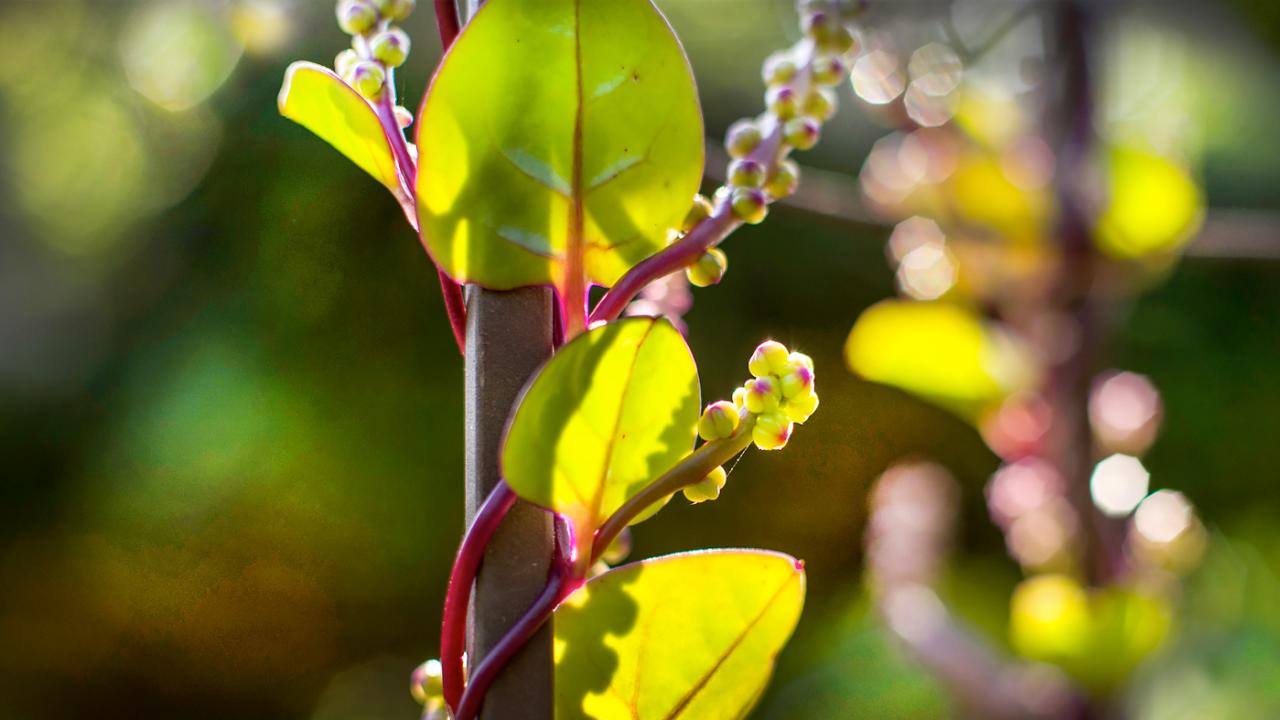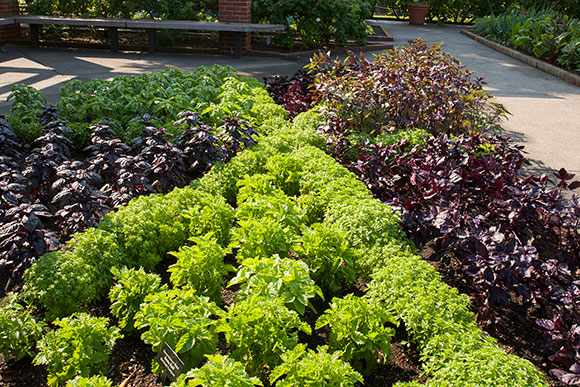

Plants & Gardening
Garden Stories
So many basils, so little time…
The Regenstein Fruit & Vegetable Garden is the place to explore small-space gardening.

Seven types of basil (listed below) were planted in the basil bed at the Regenstein Fruit & Vegetable Garden.
There, basil is king. (Of course it is—the word basil is rooted in the Greek basilikos, meaning royalty.) The bed is planted with seven very different basil varieties, laid out in a pinwheel design, and all grown from seed. It’s enough to make a gardener’s—or a foodie’s—head spin with plans for dinner…and for your own herb garden. Discover these varieties of Ocimum basilicum:
‘Dwarf Fine Bush’ – The neat round globes that divide the pinwheel pack a big punch in those tiny leaves. This basil is highly aromatic, rich with cinnamon/anise/clove flavors. Although the leaves are too little to pluck for pesto, sprinkle them on hors d’oeuvres, or use them as a garnish on any dish. Really nice for nibbling, too.
‘Crimson King’ – It’s a Genovese-style basil, with big, curvy leaves, colored purple instead of green—the better to stand out in vegetable dishes, layered in a sandwich, or as a revelation with rice.
‘Serata’ – As the name says, this is basil with serrated edges. Big, ruffly, bright green leaves make ‘Serata’ pretty enough for the front of the flower bed. But it’s truly tasty, too, with real basil flavor, so it’s a great choice for pesto.
‘Ararat’ – Showstopping in a pot on a sunny porch or patio, bicolor ‘Ararat’ is green wherever it’s not purple. Its licorice taste immediately challenges your inner foodie: Salads? Tomato dishes? Ice cream?
‘Genovese Compact Improved’ – A relative of the classic Genovese, this is more compact in overall size. With the same big leaves and concentrated, sweet flavor—though more noticeably less anise in taste—this is the perfect basil for pesto.
‘Purple Ruffles’ – The name tells you what you need to know: it’s a beautiful basil, with a more complex cinnamon/spice/mint/anise flavor. Steep it in white wine vinegar for fresh vinaigrettes all summer and fall.
‘Purple Osmin’ – Fruity and sweet, this is one of the darkest of all basils, and delicious in Italian and Thai recipes.
‘Sweet Thai’ – The distinctive spicy flavor of anise and clove make this the basil for red and green Thai curries and pho. Its purple flowers mix nicely in container or window box plantings.
‘Mrs. Burns’ Lemon’ – Pluck the lemony leaves for iced teas and lemonades, and use them generously when grilling.
That’s nine basil varieties to add to your summer repertoire. Need a kickstarter recipe? Paul Choi, who served as Garden Café executive chef, shares his lemony pesto recipe below.
Five Tips for Harvesting Basil
- Use scissors to clip individual basil leaves from the plant rather than tearing them off—much neater!
- Harvest basil branches with a clean cut across the stem, then stand them in cool water ‘til you’re ready to use.
- Harvest a whole plant by cutting straight across the main stem, leaving at least one leaf node with two shoots—the plant will rebranch from there.
- Start a new batch of seed every month from February (indoors) through September (bring plants in if nighttime temperatures dip below 50° Fahrenheit) for a continuous, fresh supply.
- Picked too much basil (is that possible)? Chop extra leaves, layer them into ice cube trays, fill with water or olive oil, and freeze. The individual cubes are great for cooking.

Pesto-licious!
Garden-fresh Pesto
8 ounces fresh basil leaves
1-2 lemons, juiced and zested*
½ cup extra virgin olive oil
¼ cup pine nuts (optional)
3 tablespoons chopped garlic
1 cup Parmesan, grated
1 tablespoon kosher salt
1 tablespoon ground black pepper
*Chef Choi prefers two for a zingier taste.
Place the pine nuts, garlic, and basil in a food processor. Process for about 30 seconds or until everything is chopped. With the processor running, slowly add the oil until the pesto is thoroughly puréed. Add the rest of your ingredients and purée until all are incorporated.
Store the pesto in the refrigerator for up to three days. The pesto must be stored with plastic wrap or another cover to keep air out. Or freeze in ice cube trays—just add a cube to any dish for extra flavor.

